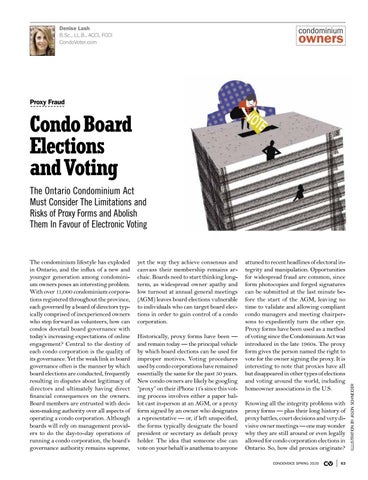Denise Lash B.Sc., LL.B., ACCI, FCCI CondoVoter.com
condominium
owners
Proxy Fraud
Condo Board Elections and Voting
The condominium lifestyle has exploded in Ontario, and the influx of a new and younger generation among condominium owners poses an interesting problem. With over 11,000 condominium corporations registered throughout the province, each governed by a board of directors typically comprised of inexperienced owners who step forward as volunteers, how can condos dovetail board governance with today’s increasing expectations of online engagement? Central to the destiny of each condo corporation is the quality of its governance. Yet the weak link in board governance often is the manner by which board elections are conducted, frequently resulting in disputes about legitimacy of directors and ultimately having direct financial consequences on the owners. Board members are entrusted with decision-making authority over all aspects of operating a condo corporation. Although boards will rely on management providers to do the day-to-day operations of running a condo corporation, the board’s governance authority remains supreme,
yet the way they achieve consensus and canvass their membership remains archaic. Boards need to start thinking longterm, as widespread owner apathy and low turnout at annual general meetings (AGM) leaves board elections vulnerable to individuals who can target board elections in order to gain control of a condo corporation. Historically, proxy forms have been — and remain today — the principal vehicle by which board elections can be used for improper motives. Voting procedures used by condo corporations have remained essentially the same for the past 50 years. New condo owners are likely be googling “proxy” on their iPhone 11’s since this voting process involves either a paper ballot cast in-person at an AGM, or a proxy form signed by an owner who designates a representative — or, if left unspecified, the forms typically designate the board president or secretary as default proxy holder. The idea that someone else can vote on your behalf is anathema to anyone
attuned to recent headlines of electoral integrity and manipulation. Opportunities for widespread fraud are common, since form photocopies and forged signatures can be submitted at the last minute before the start of the AGM, leaving no time to validate and allowing compliant condo managers and meeting chairpersons to expediently turn the other eye. Proxy forms have been used as a method of voting since the Condominium Act was introduced in the late 1960s. The proxy form gives the person named the right to vote for the owner signing the proxy. It is interesting to note that proxies have all but disappeared in other types of elections and voting around the world, including homeowner associations in the U.S. Knowing all the integrity problems with proxy forms — plus their long history of proxy battles, court decisions and very divisive owner meetings — one may wonder why they are still around or even legally allowed for condo corporation elections in Ontario. So, how did proxies originate? CONDOVOICE SPRING 2020
CV
63
ILLUSTRATION BY JASON SCHNEIDER
The Ontario Condominium Act Must Consider The Limitations and Risks of Proxy Forms and Abolish Them In Favour of Electronic Voting
